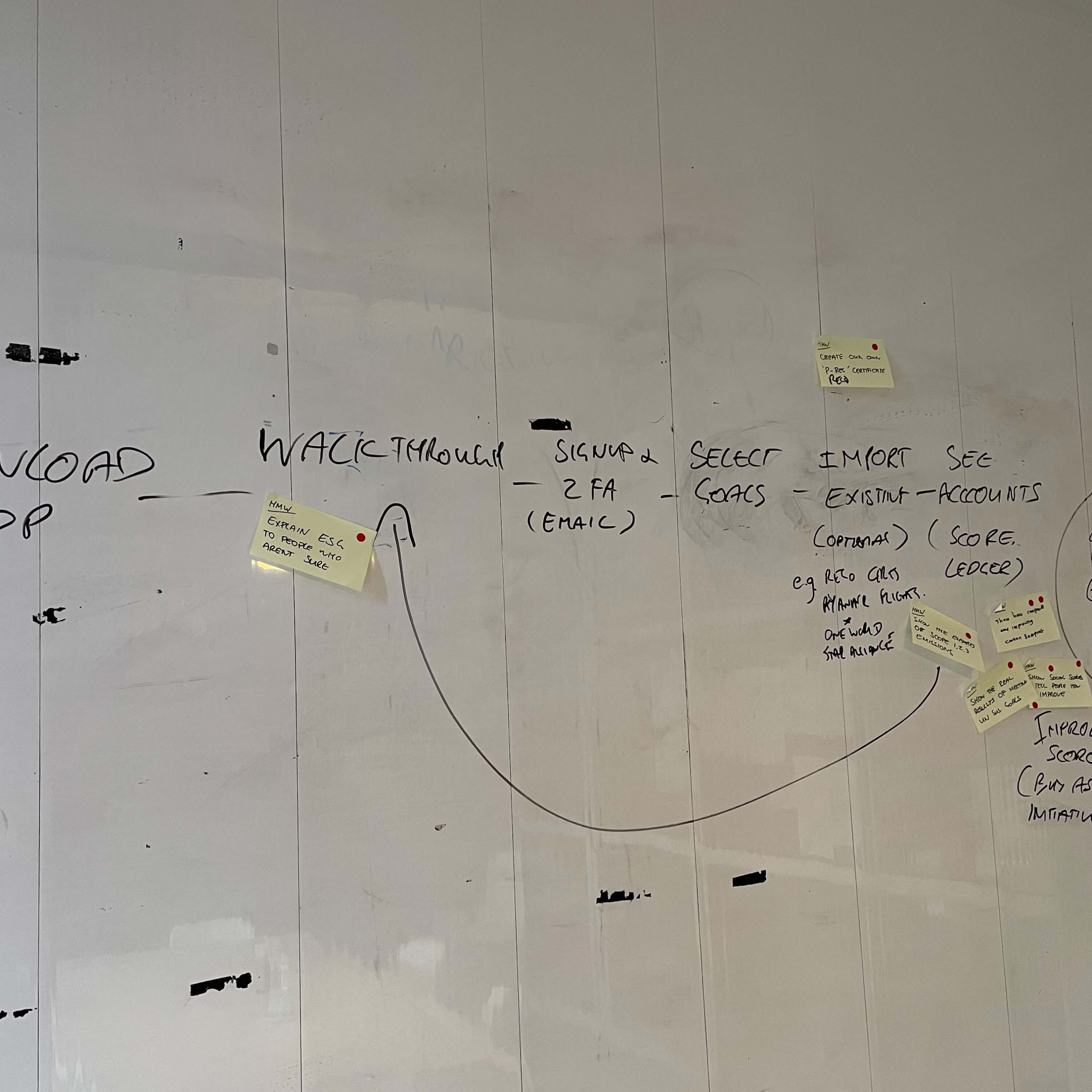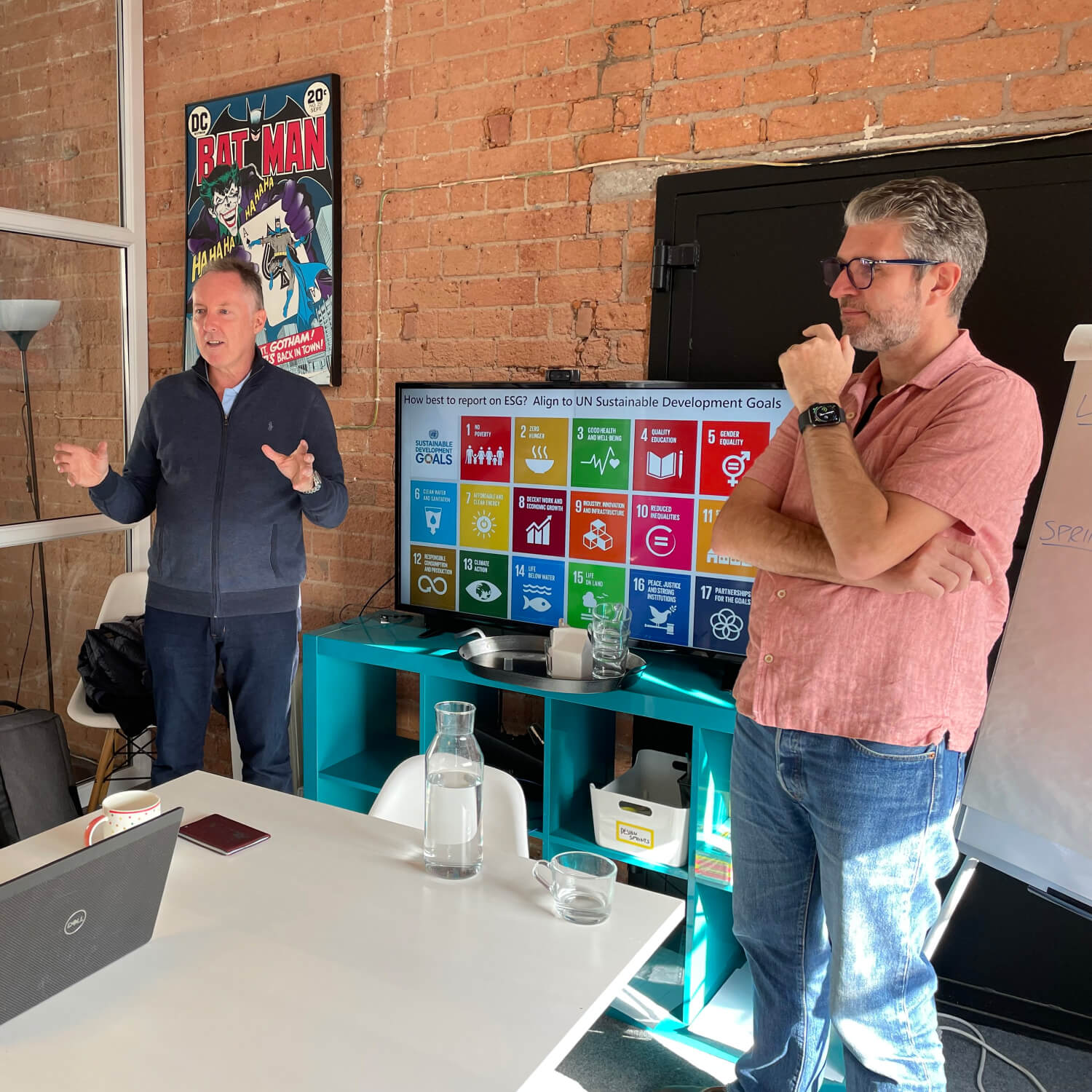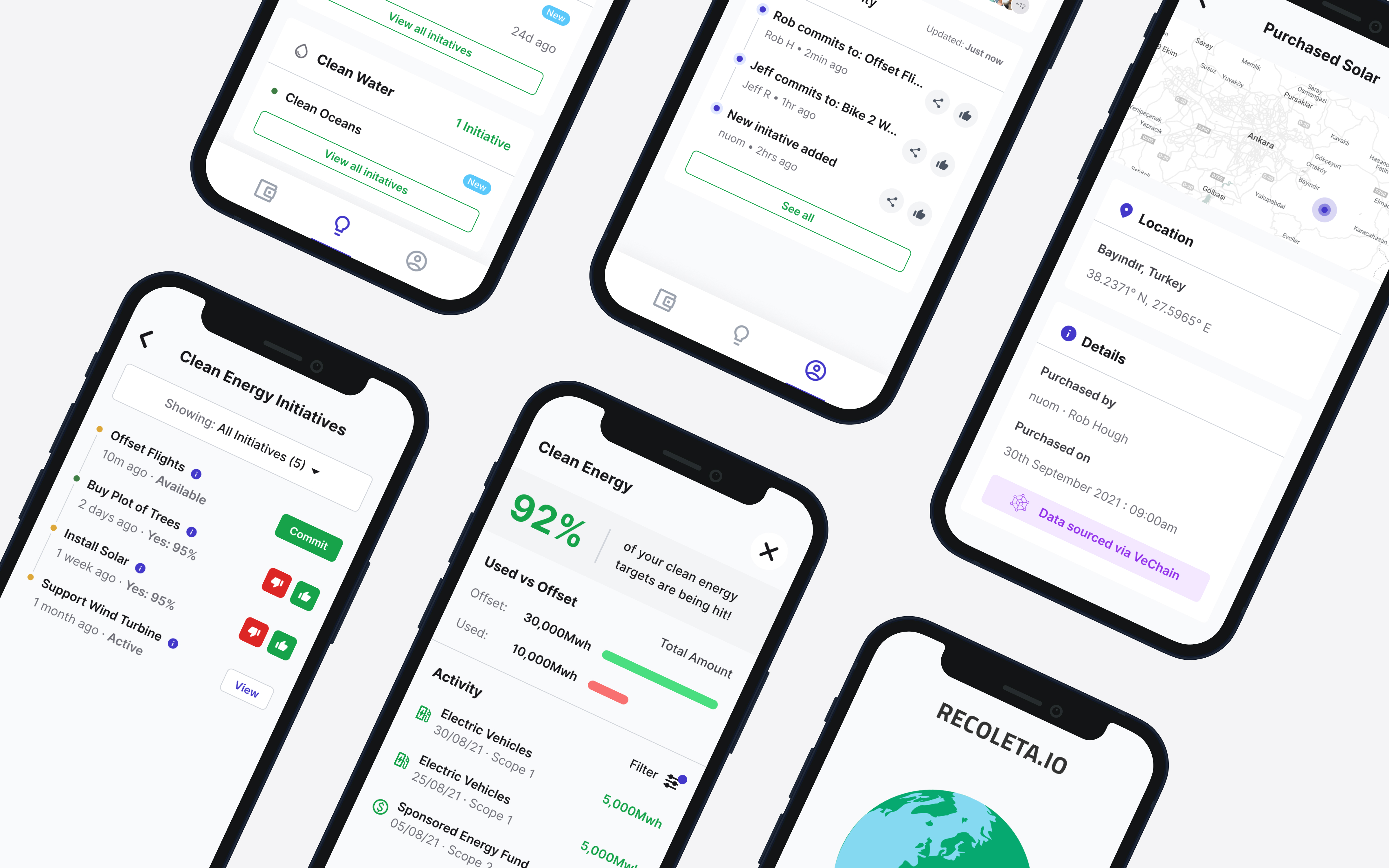

Giving organisations the tools to actively reduce their carbon footprint
In just 5 days, we helped Recoleta validate a product to help organisations and their employees track their energy usage and set targets to reduce their carbon footprint

Understanding the product idea
We kicked off the sprint by listening to the Recoleta team give their Expert Talk and explain the ins-and-outs of their product, including their goals and how they hope to make a difference.
It was during this initial discussion that we were able to get a clearer understanding of the product and what Recoleta were hoping to achieve, both short and longer term.
This talk was also a chance for us to take notes and begin thinking about which areas to focus on so that we could get the biggest wins possible in such a short time.
This workshop also helped us figure out what our main Sprint Questions were for us to test:
- Can we explain ESG, UN Sustainability Goals, and GPPP?
- Can we show users what their sustainability score is? Will they understand it?
- Can we encourage people to get involved in initiatives and share them with their org?
Deciding which areas to focus on
A big part of Recoleta's vision is to create a clear, immutable data source so that employees and organisations alike can track their activity and monitor their carbon input/output. For example, organisations might want to track how much energy they're using in a factory, and then find a more sustainable way to offset that usage such as investing in a tree planting scheme.
Due to the complexity of the product, we quickly realised that we'd need to offer a solid onboarding or educational area to explain what the aim of the app is.
A few key areas we were keen to test revolved around the UN Sustainability goals, and explaining what they were and how they can play a role in helping you manage your carbon footprint.
We also wanted to test the idea of adding a social aspect so that users could see not only what their colleagues were achieving, but also any big company milestones or news. By doing this, we were hoping it would tap into the familiarity of social media as well as add a sense of gamification and competitiveness to the experience.


Helping the planet one pixel at a time
After two days of downloading the information and putting together a plan of action, we got to work on creating a high-fidelity prototype for us to test with a handful of people that fit the ideal user archetype.
The key sections we focussed on were the initial onboarding and learning area, the adding and managing of sustainability goals which we compared to a digital wallet or banking app, and the idea of committing to a target and voting on new initiatives.
By focussing on these three areas, we knew we'd be able to test the bulk of our assumptions and ideas to understand more about the way in which people respond to these features and whether the value was there. These tests would also help us understand what does and doesn't work, as well as potentially spot any areas of opportunity we might not have considered.
We also explored the idea of having an overall sustainability score for each goal. This score is essentially a percentage out of 100 in relation to how many targets you are hitting within a specific goal (e.g., Planting more trees to offset your carbon emissions).
Testing with real users
Once we'd created a clickable prototype, we sat down 1:1 with a handful of users over a Zoom call to put our ideas to the test. We first asked them about their job role and company, and then shared the prototype so that we could walk them through each section and gather their thoughts and opinions on the different aspects of the product.
We had users complete a series of tasks within the prototype while we observed their behaviour and response to using it. We also asked them to think out aloud along the way so that we could get a clearer understanding of what they were thinking and feeling. These comments were then noted down and mapped to the main sprint questions we wanted to answer.
Collecting valuable feedback and insights
Having tested the prototype, we found that there was definitely a strong interest in the product idea. Every participant we spoke to could see it making an immediate impact in their company, and the idea of turning it into more of a social activity was well received as it felt like a bit of friendly competition that would also drive user engagement.
People also commented that they liked seeing the energy usage listed as 'transactions', and that the ability to see your overall score and find ways to improve it provided a great incentive for both staff and corporations to commit to sustainability.
The only issues we found were around the onboarding and setup. There's so much initial setup and information to take in that users found it was quite confusing to do in the app, especially if they had no prior knowledge about the process to begin with.

Thinking about the next steps
For the most part, the product idea resonated well with all testing participants. After just five days, we could already see how Recoleta could drive real change in businesses and provide an incentive for them to commit to being more sustainable.
With the initial onboarding, we suggested moving that to a more manual process during the sales cycle. As this setup needs to be done by a key decision maker, we felt this could be done before people download the app. That way, the data already exists when the users first login.
Overall, the Design Sprint proved to be very worthwhile, and we look forward to working with the Recoleta team in the future to help take their product to the next level.
Like this? You'll love some of our other projects too
Giving organisations the tools to actively reduce their carbon footprint
In just 5 days, we helped Recoleta validate a product to help organisations and their employees track their energy usage and set targets to reduce their carbon footprint
Understanding the product idea
We kicked off the sprint by listening to the Recoleta team give their Expert Talk and explain the ins-and-outs of their product, including their goals and how they hope to make a difference.
It was during this initial discussion that we were able to get a clearer understanding of the product and what Recoleta were hoping to achieve, both short and longer term.
This talk was also a chance for us to take notes and begin thinking about which areas to focus on so that we could get the biggest wins possible in such a short time.
This workshop also helped us figure out what our main Sprint Questions were for us to test:
- Can we explain ESG, UN Sustainability Goals, and GPPP?
- Can we show users what their sustainability score is? Will they understand it?
- Can we encourage people to get involved in initiatives and share them with their org?
Deciding which areas to focus on
A big part of Recoleta's vision is to create a clear, immutable data source so that employees and organisations alike can track their activity and monitor their carbon input/output. For example, organisations might want to track how much energy they're using in a factory, and then find a more sustainable way to offset that usage such as investing in a tree planting scheme.
Due to the complexity of the product, we quickly realised that we'd need to offer a solid onboarding or educational area to explain what the aim of the app is.
A few key areas we were keen to test revolved around the UN Sustainability goals, and explaining what they were and how they can play a role in helping you manage your carbon footprint.
We also wanted to test the idea of adding a social aspect so that users could see not only what their colleagues were achieving, but also any big company milestones or news. By doing this, we were hoping it would tap into the familiarity of social media as well as add a sense of gamification and competitiveness to the experience.



Helping the planet one pixel at a time
After two days of downloading the information and putting together a plan of action, we got to work on creating a high-fidelity prototype for us to test with a handful of people that fit the ideal user archetype.
The key sections we focussed on were the initial onboarding and learning area, the adding and managing of sustainability goals which we compared to a digital wallet or banking app, and the idea of committing to a target and voting on new initiatives.
By focussing on these three areas, we knew we'd be able to test the bulk of our assumptions and ideas to understand more about the way in which people respond to these features and whether the value was there. These tests would also help us understand what does and doesn't work, as well as potentially spot any areas of opportunity we might not have considered.
We also explored the idea of having an overall sustainability score for each goal. This score is essentially a percentage out of 100 in relation to how many targets you are hitting within a specific goal (e.g., Planting more trees to offset your carbon emissions).
Testing with real users
Once we'd created a clickable prototype, we sat down 1:1 with a handful of users over a Zoom call to put our ideas to the test. We first asked them about their job role and company, and then shared the prototype so that we could walk them through each section and gather their thoughts and opinions on the different aspects of the product.
We had users complete a series of tasks within the prototype while we observed their behaviour and response to using it. We also asked them to think out aloud along the way so that we could get a clearer understanding of what they were thinking and feeling. These comments were then noted down and mapped to the main sprint questions we wanted to answer.
Collecting valuable feedback and insights
Having tested the prototype, we found that there was definitely a strong interest in the product idea. Every participant we spoke to could see it making an immediate impact in their company, and the idea of turning it into more of a social activity was well received as it felt like a bit of friendly competition that would also drive user engagement.
People also commented that they liked seeing the energy usage listed as 'transactions', and that the ability to see your overall score and find ways to improve it provided a great incentive for both staff and corporations to commit to sustainability.
The only issues we found were around the onboarding and setup. There's so much initial setup and information to take in that users found it was quite confusing to do in the app, especially if they had no prior knowledge about the process to begin with.


Thinking about the next steps
For the most part, the product idea resonated well with all testing participants. After just five days, we could already see how Recoleta could drive real change in businesses and provide an incentive for them to commit to being more sustainable.
With the initial onboarding, we suggested moving that to a more manual process during the sales cycle. As this setup needs to be done by a key decision maker, we felt this could be done before people download the app. That way, the data already exists when the users first login.
Overall, the Design Sprint proved to be very worthwhile, and we look forward to working with the Recoleta team in the future to help take their product to the next level.





